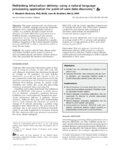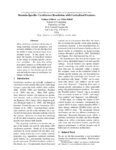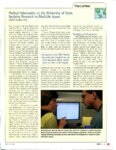TO
| Creator | Title | Description | Subject | Date | ||
|---|---|---|---|---|---|---|
| 1 |
 | Stoddart, Joan | Rethinking information delivery: using a natural language processing application for point-of-care data discovery | Objective: This paper examines the use of Semantic MEDLINE, a natural language processing application enhanced with a statistical algorithm known as Combo, as a potential decision support tool for clinicians. Semantic MEDLINE summarizes text in PubMed citations, transforming it into compact declarat... | 2012-01-01 | |
| 2 |
 | Riloff, Ellen M. | Information extraction as a stepping stone toward story understanding | Historically story understanding systems have depended on a great deal of handcrafted knowledge. Natural language understanding systems that use conceptual knowledge structures (Schank and Abelson 1977; Cullingford 1978; Wilensky 1978; Carbonell 1979; Lehnert 1981; Kolodner 1983) typically rely on ... | Information extraction; Story understanding | 1999 |
| 3 |
 | Riloff, Ellen M. | OpinionFinder: a system for subjectivity analysis | OpinionFinder is a system that performs subjectivity analysis, automatically identifying when opinions, sentiments, speculations and other private states are present in text. Specifically, OpinionFinder aims to identify subjective sentences and to mark various aspects of the subjectivity in the... | OpinionFinder; Subjectivity analysis | 2005 |
| 4 |
 | Riloff, Ellen M. | Corpus-based approach for building semantic lexicons | Semantic knowledge can be a great asset to natural language processing systems, but it is usually hand-coded for each application. Although some semantic information is available in general-purpose knowledge bases such as Word Net and Cyc, many applications require domain-specific lexicons that repr... | Corpus-based method; Semantic lexicons | 1997 |
| 5 |
 | Riloff, Ellen M. | Bootstrapping method for learning semantic lexicons using extraction pattern contexts | This paper describes a bootstrapping algorithm called Basilisk that learns high-quality semantic lexicons for multiple categories. Basilisk begins with an unannotated corpus and seed words for each semantic category, which are then bootstrapped to learn new words for each category. Basilisk hypothe... | Basilisk; Bootstrapping method; Semantic lexicons | 2002 |
| 6 |
 | Riloff, Ellen M. | Automatically constructing a dictionary for information extraction tasks | Knowledge-based natural language processing systems have achieved good success with certain tasks but they are often criticized because they depend on a domain-specific dictionary that requires a great deal of manual knowledge engineering. This knowledge engineering bottleneck makes knowledge-based ... | Information extraction; Dictionary construction; Knowledge-based systems; AutoSlog; Domain-specific dictionary | 1993 |
| 7 |
 | Riloff, Ellen M. | Exploiting role-identifying nouns and expressions for information extraction | We present a new approach for extraction pattern learning that exploits role-identifying nouns, which are nouns whose semantics reveal the role that they play in an event (e.g., an "assassin" is a perpetrator). Given a few seed nouns, a bootstrapping algorithm automatically learns role-identifying ... | Information extraction; Role-identifying; Nouns; Expressions; Pattern learning; Basilisk bootstrapping algorithm | 2007 |
| 8 |
 | Riloff, Ellen M. | Automatically generating extraction patterns from untagged text | Many corpus-based natural language processing systems rely on text corpora that have been manually annotated with syntactic or semantic tags. In particular, all previous dictionary construction systems for information extraction have used an annotated training corpus or some form of annotated input... | Information extraction; Automatically generating; Extraction patterns; Untagged text; Corpus-based; AutoSlog-TS; AutoSlog system; MUC-4; Dictionary construction | 1996 |
| 9 |
 | Riloff, Ellen M. | Empirical approach to conceptual case frame acquisition | Conceptual natural language processing systems usually rely on case frame instantiation to recognize events and role objects in text. But generating a good set of case frames for a domain is time-consuming, tedious, and prone to errors of omission. We have developed a corpus-based algorithm for a... | Conceptual case frame acquisition; Case frame instantiation; Corpus-based algorithm | 1998 |
| 10 |
 | Riloff, Ellen M. | Identifying sources of opinions with conditional random fields and extraction patterns | Recent systems have been developed for sentiment classification, opinion recognition, and opinion analysis (e.g., detecting polarity and strength). We pursue another aspect of opinion analysis: identifying the sources of opinions, emotions, and sentiments. We view this problem as an information ext... | Sentiment classification; Opinion recognition; Opinion analysis; Conditional random fields; AutoSlog; Sources of opinions | 2005 |
| 11 |
 | Riloff, Ellen M. | Domain-specific coreference resolution with lexicalized features | Most coreference resolvers rely heavily on string matching, syntactic properties, and semantic attributes of words, but they lack the ability to make decisions based on individual words. In this paper, we explore the benefits of lexicalized features in the setting of domain-specific coreference reso... | 2014-01-01 | |
| 12 |
 | Riloff, Ellen M. | Empirical study of automated dictionary construction for information extraction in three domains | A primary goal of natural language processing researchers is to develop a knowledge-based natural language processing (NLP) system that is portable across domains. However, most knowledge-based NLP systems rely on a domain-specific dictionary of concepts, which represents a substantial knowledge-en... | Information extraction; AutoSlog; Across domains | 1996 |
| 13 |
 | Riloff, Ellen M. | Conundrums in noun phrase coreference resolution: making sense of the state-of-the-art | We aim to shed light on the state-of-the-art in NP coreference resolution by teasing apart the differences in the MUC and ACE task definitions, the assumptions made in evaluation methodologies, and inherent differences in text corpora. First, we examine three subproblems that play a role in coref... | Noun phrase; Coreference resolution; MUC; ACE | 2009 |
| 14 |
 | Riloff, Ellen M. | Learning extraction patterns for subjective expressions | This paper presents a bootstrapping process that learns linguistically rich extraction patterns for subjective (opinionated) expressions. High-precision classifiers label unannotated data to automatically create a large training set, which is then given to an extraction pattern learning algorithm. T... | Bootstrapping process; Extraction patterns; Subjective expressions; Opinions | 2003 |
| 15 |
 | Gardner, Reed M. | Medical Informatics at the University of Utah: Applying Research to Real-Life Issues | Biomedical Informatics | 1999 | |
| 16 |
 | Riloff, Ellen M. | Exploiting strong syntactic heuristics and co-training to learn semantic lexicons | We present a bootstrapping method that uses strong syntactic heuristics to learn semantic lexicons. The three sources of information are appositives, compound nouns, and ISA clauses. We apply heuristics to these syntactic structures, embed them in a bootstrapping architecture, and combine them with... | Syntactic heuristics; Semantic lexicons; Bootstrapping method; Appositives; Compound nouns; ISA clauses; Co-training | 2002 |
| 17 |
 | Riloff, Ellen M. | Learning subjective nouns using extraction pattern bootstrapping | We explore the idea of creating a subjectivity classifier that uses lists of subjective nouns learned by bootstrapping algorithms. The goal of our research is to develop a system that can distinguish subjective sentences from objective sentences. First, we use two bootstrapping algorithms that explo... | Subjective nouns; Bootstrapping; Extraction patterns; Subjectivity classifier; Naive Bayes classifier | 2003 |
| 18 |
 | Riloff, Ellen M. | Corpus-based semantic lexicon induction with web-based corroboration | Various techniques have been developed to automatically induce semantic dictionaries from text corpora and from the Web. Our research combines corpus-based semantic lexicon induction with statistics acquired from the Web to improve the accuracy of automatically acquired domain-specific dictionari... | Corpus-based; Text corpora; Domain-specific dictionaries; Bootstrapping algorithm | 2009 |
| 19 |
 | Riloff, Ellen M. | Learning domain-specific information extraction patterns from the web | Many information extraction (IE) systems rely on manually annotated training data to learn patterns or rules for extracting information about events. Manually annotating data is expensive, however, and a new data set must be annotated for each domain. So most IE training sets are relatively small. C... | Information extraction; Domain-specific; Annotated training sets; MUC-4 | 2006 |
| 20 |
 | Riloff, Ellen M. | Corpus-based bootstrapping algorithm for semi-automated semantic lexicon construction | Many applications need a lexicon that represents semantic information but acquiring lexical information is time consuming. We present a corpus-based bootstrapping algorithm that assists users in creating domain-specifi c semantic lexicons quickly. Our algorithm uses a representative text corpus for ... | Bootstrapping algorithm; Lexicon construction | 1999-06 |
| 21 |
 | Riloff, Ellen M. | Learning dictionaries for information extraction by multi-level bootstrapping | Information extraction systems usually require two dictionaries: a semantic lexicon and a dictionary of extraction patterns for the domain. We present a multilevel bootstrapping algorithm that generates both the semantic lexicon and extraction patterns simultaneously. As input, our technique requir... | Information extraction; Extraction patterns; Multi-level bootstrapping; Learning dictionaries | 1999 |
| 22 |
 | Riloff, Ellen M. | Inducing information extraction systems for new languages via cross-language projection | Information extraction (IE) systems are costly to build because they require development texts, parsing tools, and specialized dictionaries for each application domain and each natural language that needs to be processed. We present a novel method for rapidly creating IE systems for new languages by... | Information extraction; IE systems; Cross-language projection; English; French | 2002 |
| 23 |
 | Riloff, Ellen M. | Semantic class learning from the web with hyponym pattern linkage graphs | We present a novel approach to weakly supervised semantic class learning from the web, using a single powerful hyponym pattern combined with graph structures, which capture two properties associated with pattern-based extractions: popularity and productivity. Intuitively, a candidate is popular if ... | Weakly supervised; Semantic class learning; Hyponym pattern; Pattern-based extractions; Class name; Seed instance | 2008 |
| 24 |
 | Riloff, Ellen M. | Learning to identify reduced passive verb phrases with a shallow parser | Our research is motivated by the observation that NLP systems frequently mislabel passive voice verb phrases as being in the active voice when there is no auxiliary verb (e.g., "The man arrested had a long record"). These errors directly impact thematic role recognition and NLP applications that dep... | Passive voice; Reduced passive verb phrases; Shallow parser; Learned classifier | 2008 |
| 25 |
 | Riloff, Ellen M. | Rule-based question answering system for reading comprehension tests | We have developed a rule-based system, Quarc, that can read a short story and find the sentence in the story that best answers a given question. Quarc uses heuristic rules that look for lexical and semantic clues in the question and the story. We have tested Quarc on reading comprehension tests typi... | Quarc; Reading comprehension | 2000 |
